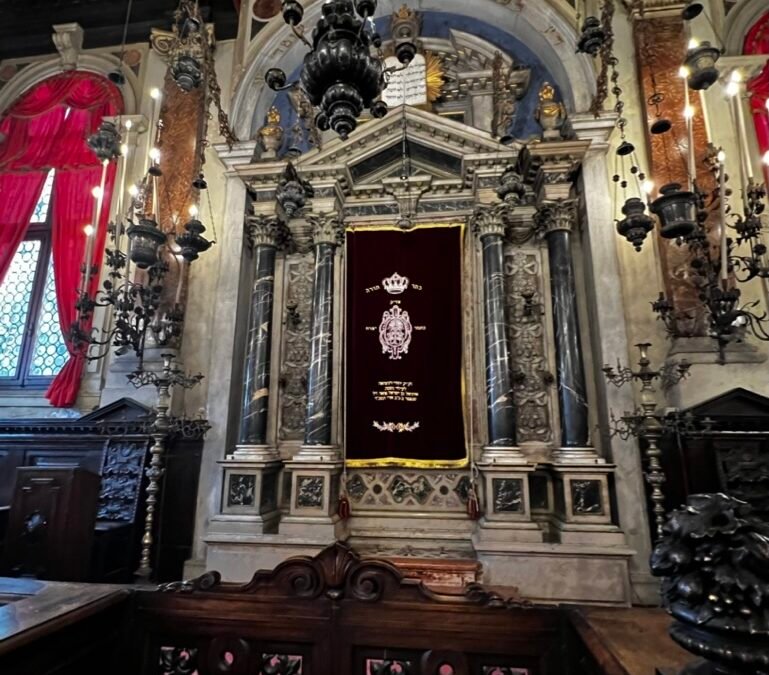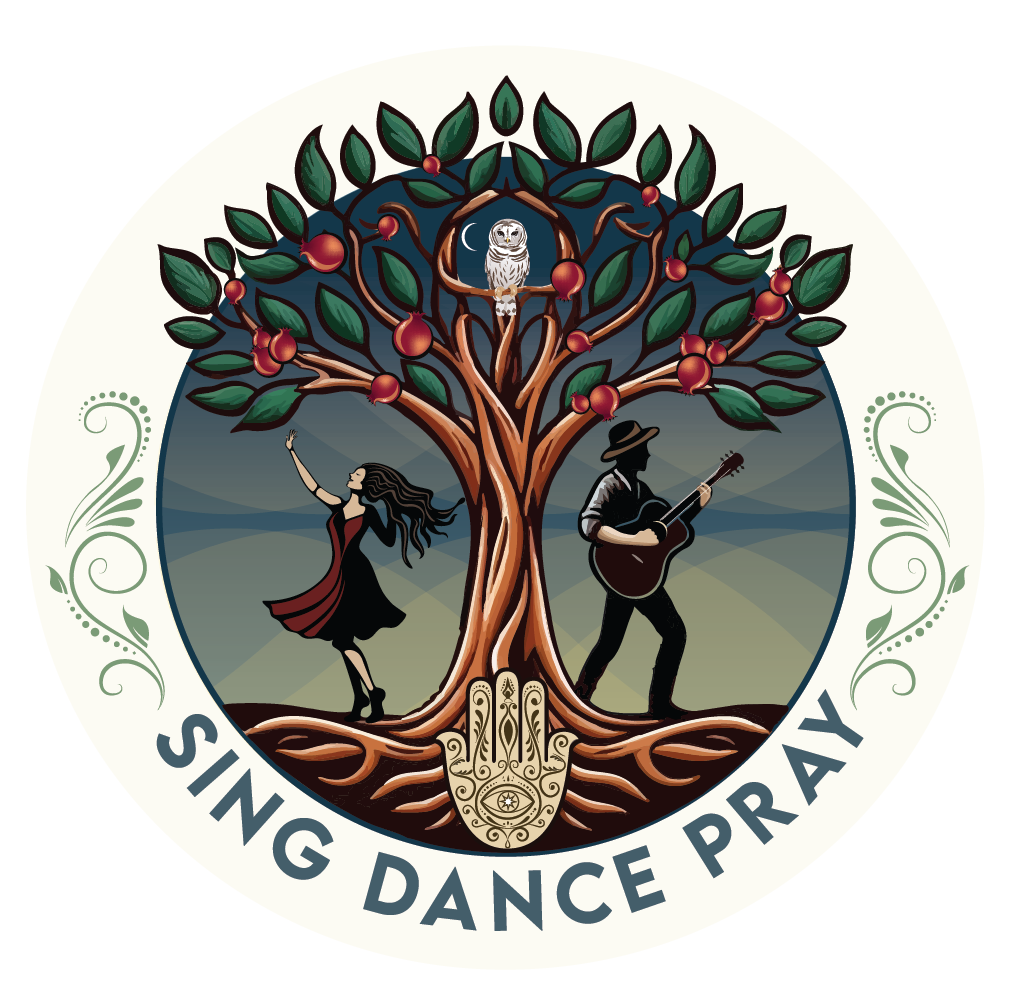I’m on a train rolling through the Austrian Alps. I’m listening to Beethoven’s Archduke Trio as we slip in and out of tunnels— A green, rainy May afternoon appears and then we are plunged back into pitch black.
My mind wanders. Who built these tunnels? How many hands picked and shoveled? How many men laid the tracks I’m flying on? Who designed this train, and who’s driving it? I’ll glide to my destination without ever knowing their names.
I am reflecting on my visit, yesterday, to the Jewish Ghetto of Venice.
The first official ghetto in Europe, it became a ‘melting pot’ of Jews from across the European continent and the Ottoman Empire. Fleeing the Spanish Inquisition and other persecutions, Jews found relative safety in Venice. Though denied rights and citizenship (not granted until Napoleon’s 1797 invasion), life was marginally better.
One theory about the origin of the word Ghetto says it originates in Venice because the Doge allowed Jews to settle in a foundry district where metal scraps—gettati—were discarded. Ashkenazi Jews pronounced it “ghetto,” and the name stuck.
With Venice’s neighborhoods divided by canals, it was easy for authorities to close gates each night, locking Jews inside.
So began the ghettoization of Jews from diverse cultures and languages, unified only by shared prayers in Hebrew, Aramaic, and some Yiddish. Each community built its own scola (shul), reflecting its traditions and wealth.
Five synagogues functioned, the Levantine (Turkish) Shul being the largest and most ornate. Built discreetly, often on upper floors for light and secrecy, they were invisible from the street. Unlike Venice’s opulent churches, these buildings were intentionally plain—hidden sanctuaries for a faith mostly forbidden in public.
Still, the community flourished, growing from a few hundred to over 5,000. Barred from most trades, including carpentry, Jews couldn’t build new homes and had to hire Christian workers to build upward. That’s why the Ghetto holds some of Venice’s tallest buildings.
We had only a day and a half in Venice during our two-week journey through Italy and Austria, but I was determined to visit the two synagogues open to the public. Miraculously, they’re still in use. You check in at the Museo Ebraico and pay €12 for a tour. I found the simple doors as children played soccer in the courtyard, shouting joyfully in Italian.
I entered the Spanish/Sephardic synagogue and climbed old wooden stairs into the sanctuary. A tour group was ahead, and I listened as the guide described the room. The Aron HaKodesh (Ark) faced south toward Jerusalem, unlike the east-facing arks in the U.S. The bimah stood at the opposite end of the room. Benches along either side faced inward, and a balcony circling above housed the women’s section.
The chandeliers and candle holders now use electric lights, but I imagined them once lit with wax tapers, scenting the room with tallow and smoke. Near the Ark stood massive candle holders—four to five feet tall. Who made those enormous candles to light a room full of swaying souls?
After the group left, I was alone, except for a security guard scrolling her phone. The emotions I’d been holding back overflowed. Tears rolled down my face.
What was I feeling? The echo of centuries of Torah chanting. The ghosts of those who sat in these pews. Weddings, bar mitzvahs, mourners reciting Kaddish. Five hundred years of prayer soaked into chestnut benches.
There were tears of reverence and gratitude, yes, but there was something else.
I looked up and wept for the women who had been confined to the balcony, separated from the sacred scrolls, from the heart of the prayer ritual.
Has a woman’s voice ever chanted Torah here? Even in 2025, as a trained rabbinical student, I wouldn’t be permitted to do so.
Once again, I sat in the tension between my love for Jewish prayer, history, and community—and my grief over its exclusion of women from religious leadership. It arises in moments. It’s like I become a lightning rod for some collective pool of frustration, anger, and grief. Those who were capable, wise, learned, and yet denied access. Not allowed to publicly interact with the scrolls we call “a tree of life”.
Yes, there were exceptions. I could feel them in the room—brilliant, pious women who found ways in. And I know the community extended beyond the synagogue: midwives, herbalists, wailing women leading funeral mourners, wise women who lit Shabbat candles with powerful intention. Their prayers echo into my present-day heart, every Friday evening.
And still, I am alive in a time where the chief Rabbi of the Kotel, the western wall in Jerusalem forbids women from reading from the Torah there, even to the point of violently ripping a Torah (there are Torahs available there for those men who wish to pray with one) out of the hands of a woman and knocking her to the ground in order to stop her from reading the sacred scroll at the wall. Access was and remains restricted. I grieve that.
What might the world look like if it weren’t?
At this moment we can’t know. Not for another 500 years, perhaps—when a full body of interpretations and sacred refractions by women, queer people, and other marginalized folx has been recorded, studied, and cherished.
So, I’m standing in front of the bimah, weeping, and I heard/felt something clearly: this feeling is part of my purpose.
I heard the voices of my ancestresses—women whose songs were never allowed to rise above a whisper in this room—singing in my ears:
You are the answer to our prayers.
You can sing here.
I stood still, took a breath, and began to sing El Malei Rachamim, the prayer of sacred remembrance. Unlike the churches of Venice, where signs demand silence, the synagogue had none. The guard in the corner didn’t seem to notice—or perhaps chose not to mind.
Emboldened, I let my voice rise a bit—for the women who had never been allowed one.
Then I chanted from memory the first chapter of the Torah, through the end of the creation of the first day.
The bimah was roped off, but I asked the archangels to lift me, to let my voice become a spell—a prayer for the creation of a new era for the Jewish people.
An era unafraid to examine the traditions that have kept us bound in internal caste systems, mirroring the oppressive structures imposed on us by the outside world. An era unafraid to plumb the stories for the medicine they have for this time and draw if forth.
You’ve likely heard of the yellow stars Jews were forced to wear during the Holocaust. But did you know that in 16th-century Venice, Jews were required to wear yellow hats? Sometimes paired with a yellow circle badge, these marked us clearly as separate when we left the ghetto’s boundaries.
It takes deep reflection to see how we perpetuate, in our own communities, in humanity the world over, the very systems of exclusion we’ve suffered under.
I believe healing comes through this reckoning—and that evolving our tradition, evolving our world, requires it.
Now, just an hour and a half remains before I arrive in Vienna—home of Sigmund Freud, the Jewish pioneer of psychoanalysis, who gave language to the hidden workings of the human mind.
Utterly strange to examine the psyche. Like looking in the mirror on LSD. We might come to realize that none of this “me” that I think I am is even real, None of the real self/soul is a man, or a woman, or a Jew, or an Atheist, or….
So what is it? We move beyond the mind. We search in the realm of the liminal. We search with the soul.
It is this commitment—to truth-telling, honest looking, to deep introspection—that will save us. From ourselves and from the repetition compulsion so deeply wired into human nature.
So Do We NEED Therapy?
Yes. Religions need therapy. Nations need therapy. Families need therapy. People need therapy.
All kinds of therapy; Talk therapy, somatic therapy, creative play therapy, art therapy, erotic therapy, ritual therapy,yoga, dance, emdr, integrated family systems work … .
Pick your flavor and dive in.
Because if you don’t…
Studies show that if a child grows up in a household of abuse and then does not do the inner work of healing and alchemizing, they are 11 times more likely to engage in criminal behavior and are at higher risk for physical and mental health disorders.
People who experienced violence in their childhood homes are twice as likely to experience violence in their adult lives.
Healing yourself heals the world.
I went to therapy.
One day, weeding my garden and feeling a lot of anger and frustration at my alcoholic dad and my emotionally unavailable partner my mind growled, “If they would only get into therapy!”
And I kid you not, it was like a lightning bolt surged through my body and delivered the question;
Who needs therapy?
I peeled off my muddy gloves right then and there, marched into the house and started making some calls. A magic trail of synchronicity led me to an incredible therapist/healer (of course) and I worked with her every week for 4+ years.
With what I spent in her office I could’ve travelled the world. But it was worth it. Every penny. When I look at my life now, I know that I would not, could not, be having the experience I am, had I not been willing to use the only agency I truly had, the agency of beginning to heal myself.
We must not be afraid. Or if we are, we must do it anyway.
If you feel that you, your “people”, your religion, or your family has been victimized, scapegoated, or persecuted, then it is upon you/us to do the healing work you/we can. Lest we take that persecution and persecute others because oh we know it so well and it feels so familiar.
I know that might sound harsh, but it’s just true. Our victimizers may apologize and make reparations, and they should, but we also have a role to play in the journey of healing ourselves and our descendants from the echoes of these traumas.
As a Jewish woman living at this moment of history I know I cannot change the history of my lineage of trauma and persecution. The only thing to do is to begin to use all the available tools (and thank Goddexx there are many now!) to understand and begin to heal myself and help my community to do the same as I am able with my unique gifts.
One bright star in my heart right now is my upcoming Ashkenazic Ancestral Journey to Poland with my dear sister Julie Wolk coming up in July. She has created a container that will have healing effects in this moment and for generations to come (check it out here). I’m so honored to be helping to guide the ritual side of our journey together, and beyond amazed that I will put my feet on the earth in the Bialowieza forest where my ancestors walked and played.
May we be guided in these efforts to heal and transform ourselves by our ancestors’ wisdom and emboldened by the vision of a world made whole—for all who come after us.

